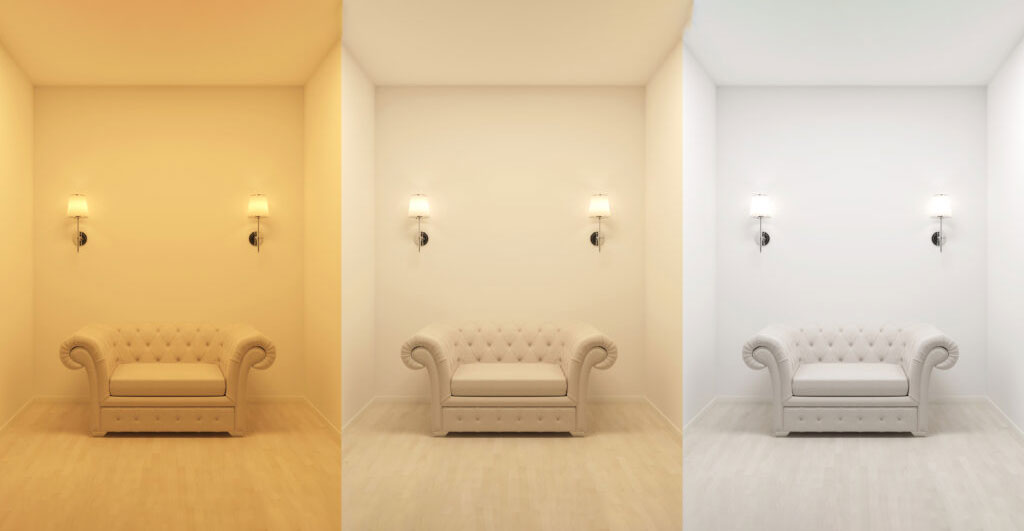Colors make the world beautiful. However, color temperature plays an important role as well. When planning to choose LED lights for your home, choosing the right color can have immense effects on how it makes your room look and feel. With the heavy amount of LED color lights available in the market right now, choosing between cool, neutral, warm, or tunable LEDs will depend on how you want to use them. This will have the desired look and feel of your application. Keep reading to find out how choosing the right color temperature can change the look and feel of your home/ room.
Color Temperature
Most LED lights and lighting products come in a range of different color temperatures in varying hues of white. Correlated color temperature or CCT is a term that defines how warm (yellow) or cool (blue) the LED bulb’s color of light emitted is. The color temperature of light is measured in Kelvin (K) units – on a scale of 1,000 to 10,000. Even the Sun’s light color temperature is also measured in Kelvin degrees. During midday, the Sun’s color temperature might be 6000K (very bright, bluish-white), while the color temperature drops below 3000K ( warm, amber light) at sunset.
When it comes to household and residential lighting applications, the color temperature falls somewhere between 2500Kelvin to 5000Kelvin.
Using Color Temperature At Home
Before you go ahead and buy the first LED light that you lay your eyes on, you need to decide whether you want to install warm or cool light? Typically, warm light is anything below or equal to 3000K; on the other hand, cool lights are anything equal to or above 4000K. 3500K is the neutral color temperature and is also seen as the middle ground between warm and cool lights. However, it can look either warm or cool depending on the room’s furnishings and nearby lighting.
Usually, lights above 4000K color temperatures are used for commercial and hospital applications because it is very bright and has a bluish daylight look and feel. However, the same light can also be too harsh for residential applications and interiors. Also, other than the type of the light bulb itself, using Kelvin temperature can help you decide the correct fixture for each room. Regardless of whether you need an ambient accent light source or a light for any highly-focused task, choosing the right light according to the color temperature can help you get the job done.
Use the following Kelvin ranges to choose the light to go with:
2200-2700K: this color temperature produces warm light. It is also best suited for low-light areas where ambient lighting is required.
3000-3500K: this color temperature produces a soft white light. Typically, the light produced is crisper than the 2700K, similar to the halogen lamps.
4000-4500K: this color temperature produces bright white light ideal for your kitchen, workspace, office, and other places where detail-oriented tasks are performed.
5000K and up: the lights with this color temperature produce a bright bluish hue of light primarily found in commercial locations.
Now that you know how different color temperature lights can be placed at different places, you can use it to apply at your home too. Moreover, you can also use different color temperature lights in different rooms according to your work in that particular room. But, if you are still not sure about the correct color temperature light placement in your home, here’s a small guide to help you decide.
Temperature Recommendations by Space/ Rooms
Bedrooms: if you want a soothing and relaxing atmosphere in your bedroom, keep the lights low and warm, which allows you to relax and rest. Suggested color temperature: 2700-3000K
Bathrooms: bathrooms should be cool and brighter to help you do the functional routines. Suggested color temperature: 3000-4000K
Living Room: living rooms are your inviting and gathering space. This is also where you’ll relax and need it to be perfect for entertaining. Using a dimmer and warm light will help set the right atmosphere. Suggested color temperature: 2700-3000K
Dining Room: in your dining room, you’ll want your lighting to be a balance between bright and dim. Suggested color temperature: 2700K – 3000K
Kitchen: bright light in the kitchen is perfect for prepping food and reading recipes. However, you can also go with a ‘neutral’ 3000K white light that will go with any setting. Suggested color temperature: 2700-4000K
Workspace / Garage: These places where you’ll need bright and functional lighting to be productive and focused. You will need something warmer during the evenings and nights and bright lights of around 4000K during the day. Suggested color temperature: 3000-5000K
There are various LED lighting systems and light bulbs that you can use to change the color temperature with a single click. You can install these lights where you spend most of your time. But for most of the other rooms of your home, you can follow the guide above to choose the light and color temperature perfect to light up the room while still setting the room’s mood for what they will be used for. At Safety Lamps Repair, we recommend using dimmer lights whenever possible. There are various reasons for recommending such lights – instant space transformation, energy-saving, and extending the life of your LED bulbs and fixtures. If you want to buy new lights for your home or office or want to get your light repaired, contact Safety Lamps Repair, and we will get the job done with expertise.


